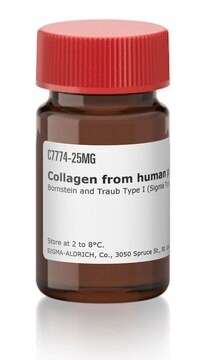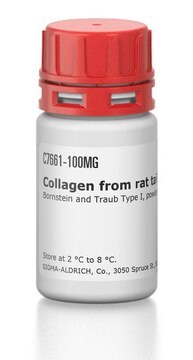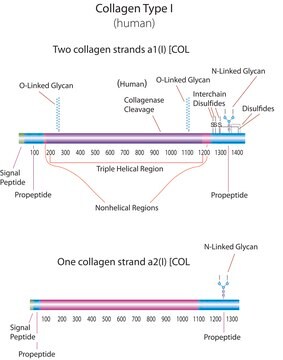CC077
Human Collagen Type V
from human placenta, liquid, 1 mg/mL, suitable for cell culture, used for gel formation
Sinónimos:
Collagen Type V
About This Item
Productos recomendados
product name
Human Collagen Type V,
origen biológico
human
Nivel de calidad
Análisis
95% (SDS-PAGE)
formulario
liquid
fabricante / nombre comercial
Chemicon®
concentración
1 mg/mL
técnicas
cell culture | mammalian: suitable
impurezas
<0.5% non-collagen proteins
<1% collagen type III
<2% collagen type I
<2% collagen type IV
entrada
sample type mesenchymal stem cell(s)
sample type induced pluripotent stem cell(s)
sample type pancreatic stem cell(s)
sample type epithelial cells
sample type neural stem cell(s)
sample type hematopoietic stem cell(s)
sample type: human embryonic stem cell(s)
Nº de acceso NCBI
Nº de acceso UniProt
Condiciones de envío
dry ice
temp. de almacenamiento
−20°C
Información sobre el gen
human ... COL5A1(1289) , COL5A2(1290)
Descripción general
Aplicación
Acciones bioquímicas o fisiológicas
Forma física
Nota de preparación
Almacenamiento y estabilidad
Otras notas
Información legal
Cláusula de descargo de responsabilidad
Código de clase de almacenamiento
12 - Non Combustible Liquids
Clase de riesgo para el agua (WGK)
WGK 1
Punto de inflamabilidad (°F)
Not applicable
Punto de inflamabilidad (°C)
Not applicable
Certificados de análisis (COA)
Busque Certificados de análisis (COA) introduciendo el número de lote del producto. Los números de lote se encuentran en la etiqueta del producto después de las palabras «Lot» o «Batch»
¿Ya tiene este producto?
Encuentre la documentación para los productos que ha comprado recientemente en la Biblioteca de documentos.
Los clientes también vieron
Artículos
Extracellular matrix proteins such as laminin, collagen, and fibronectin can be used as cell attachment substrates in cell culture.
Protocolos
This page covers the ECM coating protocols developed for four types of ECMs on Millicell®-CM inserts, Collagen Type 1, Fibronectin, Laminin, and Matrigel.
Nuestro equipo de científicos tiene experiencia en todas las áreas de investigación: Ciencias de la vida, Ciencia de los materiales, Síntesis química, Cromatografía, Analítica y muchas otras.
Póngase en contacto con el Servicio técnico




